Are Nano-Composite Coatings the Key for Photovoltaic Panel Self-Maintenance: An Experimental Evaluation
Abstract
:1. Introduction
2. Material and Methods
2.1. PV Plant Description
2.2. Measurement Devices Description
2.3. Coating Application
2.4. Data Post-Processing
3. Results and Discussion
3.1. Solar Radiation
3.2. PV Arrays Energy Production and Efficiency
3.3. Technical-Economical Analysis
- The coating is applied every year after panel washing.
- The coating increases the annual power plant energy production by 0.6% on average.
- The FV power plant benefits from a Feed In Tariff (FIT) incentive for the electrical energy produced. A value of 0.227 € per kWh was considered.
- The energy produced by the PV plant is mainly self consumed by the electrical user. A economic value of 0.2 € per kWh of self consumed electrical energy from the PV plant was considered.
- The PV plant considered has an annual PV energy production of 1200 kWh/kWp and it has an active surface area of 34.44 square meters.
4. Conclusions
Author Contributions
Funding
Acknowledgments
Conflicts of Interest
References
- IEA. Renewable Energy Medium-Term Market Report 2016; IEA PUBLICATIONS: Paris, France, 2016. [Google Scholar]
- Rajesh, R.; Mabel, M.C. A comprehensive review of photovoltaic systems. Renew. Sustain. Energy Rev. 2015, 51, 231–248. [Google Scholar] [CrossRef]
- Bucciarelli, L.L. Power loss in photovoltaic arrays due to mismatch in cell characteristics. Sol. Energy 1979, 23, 277–288. [Google Scholar] [CrossRef]
- Charles, E.; Lehman, E.; Zoellick, J.; Pauletto, G. Effects of mismatch losses in photovoltaic arrays. Sol. Energy 1995, 54, 165–171. [Google Scholar]
- Iannone, F.; Noviello, G.; Sarno, A. Monte Carlo techniques to analyse the electrical mismatch losses. Sol. Energy 1997, 62, 85–92. [Google Scholar] [CrossRef]
- MacAlpine, S.; Deline, C.; Erickson, R.; Brandemuehl, M. Module Mismatch Loss and Recoverable Power in Unshaded PV Installations. In Proceedings of the 38th IEEE Photovoltaic Specialists Conference (PVSC), Austin, TX, USA, 3–8 June 2012. [Google Scholar]
- MacAlpine, S.; Brandemuehl, M.; Erickson, R. Beyond the Module Model and Into the Array: Mismatch in Series Strings. In Proceedings of the 38th IEEE Photovoltaic Specialists Conference (PVSC), Austin, TX, USA, 3–8 June 2012. [Google Scholar]
- Wurster, T.S.; Schubert, M.B. Mismatch loss in photovoltaic systems. Sol. Energy 2014, 105, 505–511. [Google Scholar] [CrossRef]
- Lorente, D.G.; Pedrazzi, S.; Zini, G.; Rosa, A.D.; Tartarini, P. Mismatch losses in PV power plants. Sol. Energy 2014, 100, 42–49. [Google Scholar] [CrossRef]
- Fouad, M.; Shihata, L.A.; Morgan, E.I. An integrated review of factors influencing the performance of photovoltaic panels. Renew. Sustain. Energy Rev. 2017, 80, 1499–1511. [Google Scholar] [CrossRef]
- De Vos, A. Thermodynamics of Photovoltaics. In Thermodynamics of Energy Conversion and Transport; Sieniutycz, S., De Vos, A., Eds.; Springer: New York, NY, USA, 2000; pp. 49–71. [Google Scholar] [CrossRef]
- Kaushik, S.; Rawat, R.; Manikandan, S. An innovative thermodynamic model for performance evaluation of photovoltaic systems: Effect of wind speed and cell temperature. Energy Convers. Manag. 2017, 136, 152–160. [Google Scholar] [CrossRef]
- Siecker, J.; Kusakana, K.; Numbi, B. A review of solar photovoltaic systems cooling technologies. Renew. Sustain. Energy Rev. 2017, 79, 192–203. [Google Scholar] [CrossRef]
- Said, S. Effects of dust accumulation on performances of thermal and photovoltaic flat-plate collectors. Appl. Energy 1990, 37, 73–84. [Google Scholar] [CrossRef]
- Maghami, M.R.; Hizam, H.; Gomes, C.; Radzi, M.A.; Rezadad, M.I.; Hajighorbani, S. Power loss due to soiling on solar panel: A review. Renew. Sustain. Energy Rev. 2016, 59, 1307–1316. [Google Scholar] [CrossRef]
- Appels, R.; Lefevre, B.; Herteleer, B.; Goverde, H.; Beerten, A.; Paesen, R.; Medts, K.D.; Driesen, J.; Poortmans, J. Effect of soiling on photovoltaic modules. Sol. Energy 2013, 96, 283–291. [Google Scholar] [CrossRef]
- Pedersen, H.; Strauss, J.; Selj, J. Effect of Soiling on Photovoltaic Modules in Norway. Energy Procedia 2016, 92, 585–589. [Google Scholar] [CrossRef]
- Mejia, F.A.; Kleissl, J. Soiling losses for solar photovoltaic systems in California. Sol. Energy 2013, 95, 357–363. [Google Scholar] [CrossRef]
- Sarver, T.; Al-Qaraghuli, A.; Kazmerski, L.L. A comprehensive review of the impact of dust on the use of solar energy: History, investigations, results, literature, and mitigation approaches. Renew. Sustain. Energy Rev. 2013, 22, 698–733. [Google Scholar] [CrossRef]
- You, S.; Lim, Y.J.; Dai, Y.; Wang, C.H. On the temporal modelling of solar photovoltaic soiling: Energy and economic impacts in seven cities. Appl. Energy 2018, 228, 1136–1146. [Google Scholar] [CrossRef]
- Piliougine, M.; Cañete, C.; Moreno, R.; Carretero, J.; Hirose, J.; Ogawa, S.; de Cardona, M.S. Comparative analysis of energy produced by photovoltaic modules with anti-soiling coated surface in arid climates. Appl. Energy 2013, 112, 626–634. [Google Scholar] [CrossRef]
- Lu, H.; Lu, L.; Wang, Y. Numerical investigation of dust pollution on a solar photovoltaic (PV) system mounted on an isolated building. Appl. Energy 2016, 180, 27–36. [Google Scholar] [CrossRef]
- Lu, H.; Zhao, W. Effects of particle sizes and tilt angles on dust deposition characteristics of a ground-mounted solar photovoltaic system. Appl. Energy 2018, 220, 514–526. [Google Scholar] [CrossRef]
- Toth, S.; Muller, M.; Miller, D.C.; Moutinho, H.; To, B.; Micheli, L.; Linger, J.; Engtrakul, C.; Einhorn, A.; Simpson, L. Soiling and cleaning: Initial observations from 5-year photovoltaic glass coating durability study. Sol. Energy Mater. Sol. Cells 2018, 185, 375–384. [Google Scholar] [CrossRef]
- Sayyah, A.; Horenstein, M.N.; Mazumder, M.K. Energy yield loss caused by dust deposition on photovoltaic panels. Sol. Energy 2014, 107, 576–604. [Google Scholar] [CrossRef]
- Chen, E.Y.T.; Ma, L.; Yue, Y.; Guo, B.; Liang, H. Measurement of dust sweeping force for cleaning solar panels. Sol. Energy Mater. Sol. Cells 2018, 179, 247–253. [Google Scholar] [CrossRef]
- Quan, Y.Y.; Zhang, L.Z. Experimental investigation of the anti-dust effect of transparent hydrophobic coatings applied for solar cell covering glass. Sol. Energy Mater. Sol. Cells 2017, 160, 382–389. [Google Scholar] [CrossRef]
- Son, J.; Kundu, S.; Verma, L.K.; Sakhuja, M.; Danner, A.J.; Bhatia, C.S.; Yang, H. A practical superhydrophilic self cleaning and antireflective surface for outdoor photovoltaic applications. Sol. Energy Mater. Sol. Cells 2012, 98, 46–51. [Google Scholar] [CrossRef]
- Sutha, S.; Suresh, S.; Raj, B.; Ravi, K. Transparent alumina based superhydrophobic self–cleaning coatings for solar cell cover glass applications. Sol. Energy Mater. Sol. Cells 2017, 165, 128–137. [Google Scholar] [CrossRef]
- Prabhu, S.; Cindrella, L.; Kwon, O.J.; Mohanraju, K. Superhydrophilic and self-cleaning rGO-TiO2 composite coatings for indoor and outdoor photovoltaic applications. Sol. Energy Mater. Sol. Cells 2017, 169, 304–312. [Google Scholar] [CrossRef]
- Rifai, A.; Abu-Dheir, N.; Khaled, M.; Al-Aqeeli, N.; Yilbas, B.S. Characteristics of oil impregnated hydrophobic glass surfaces in relation to self-cleaning of environmental dust particles. Sol. Energy Mater. Sol. Cells 2017, 171, 8–15. [Google Scholar] [CrossRef]
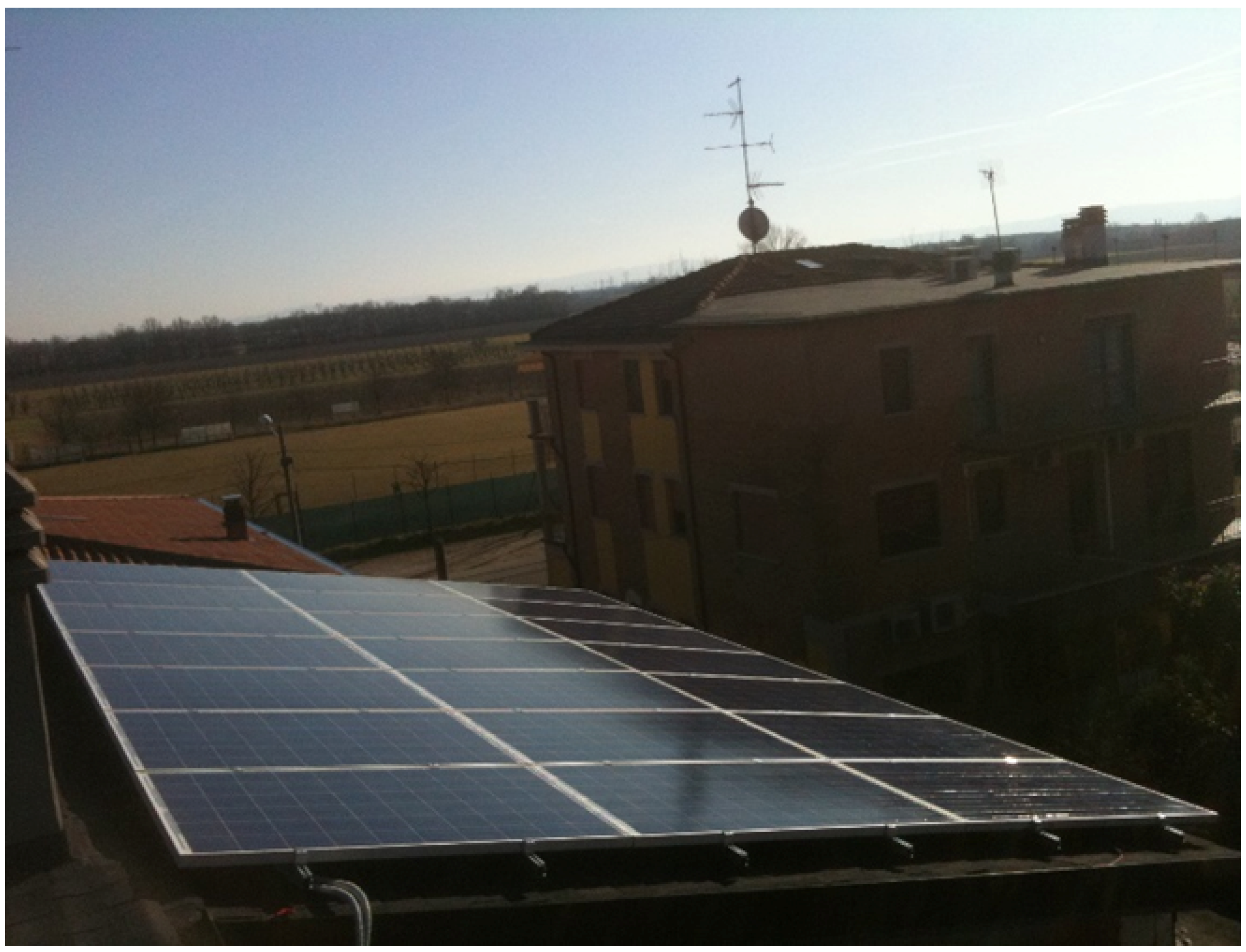
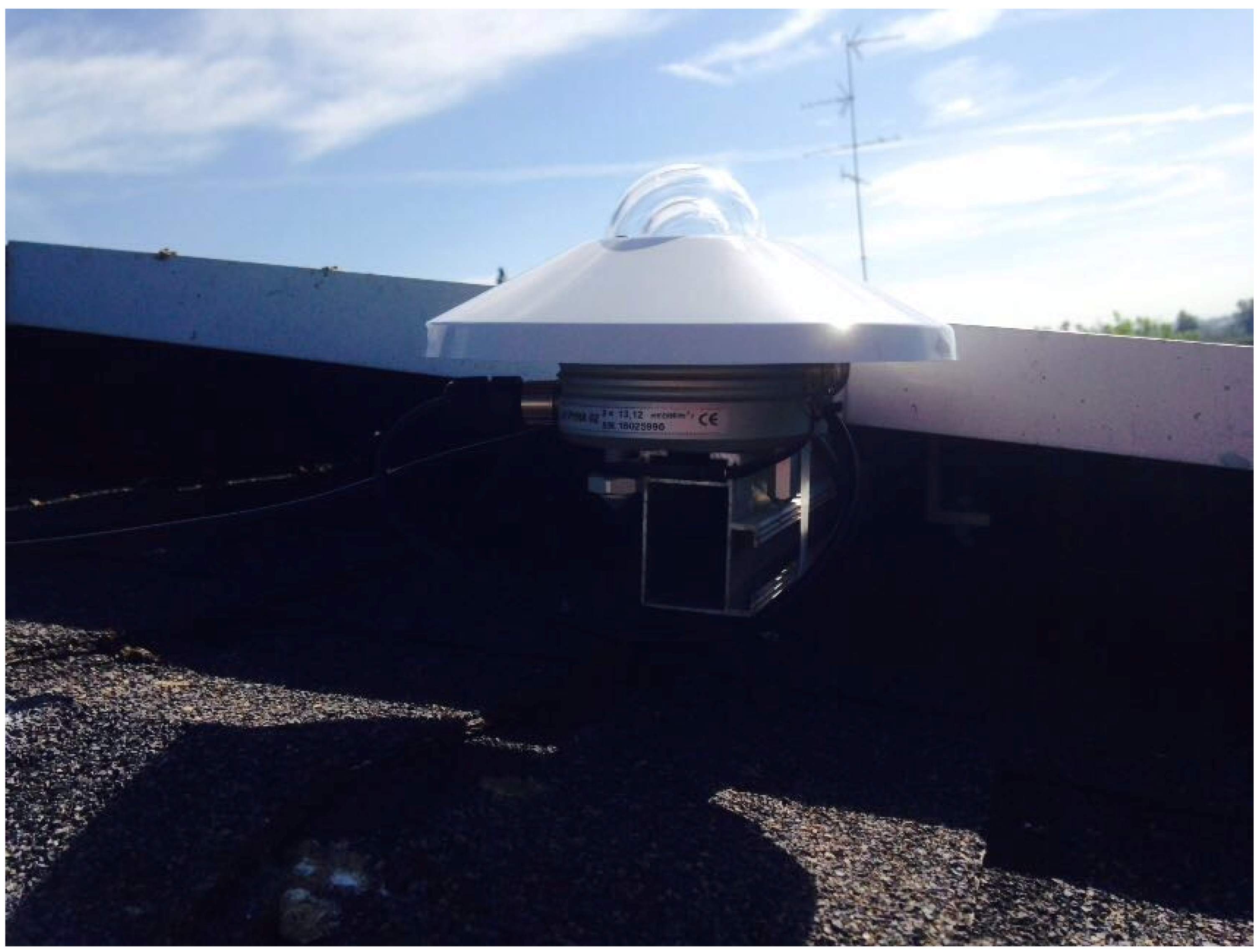
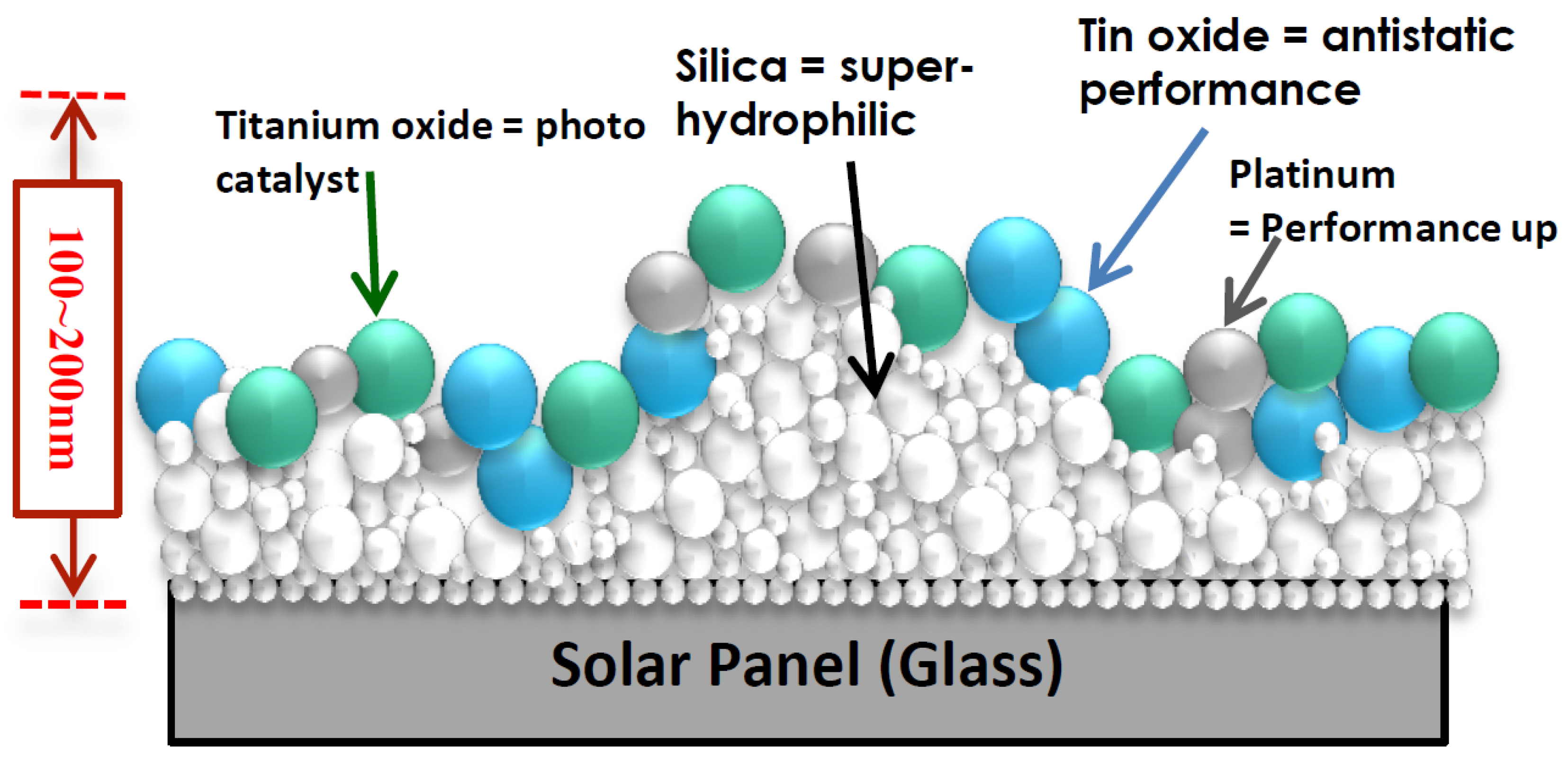
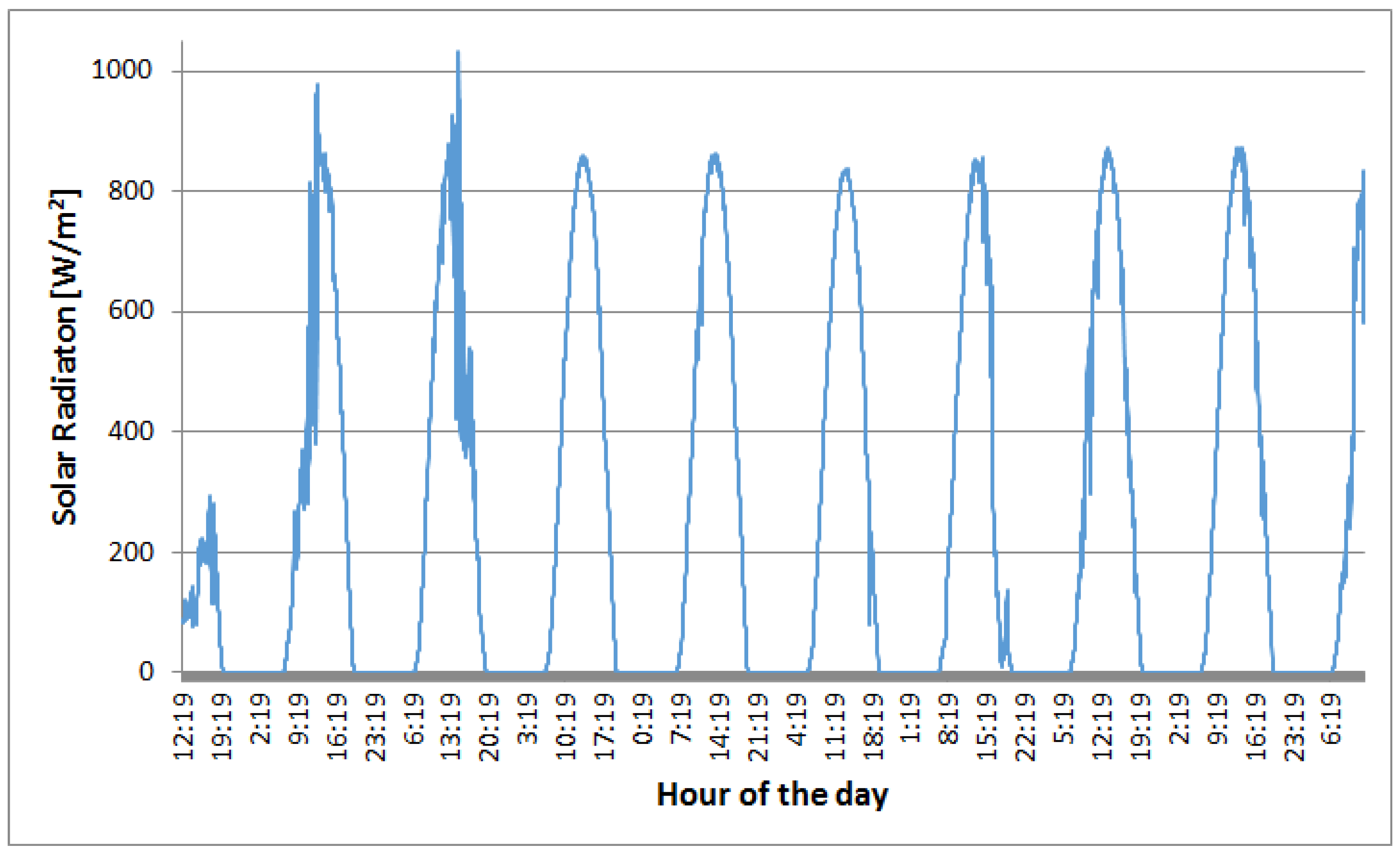
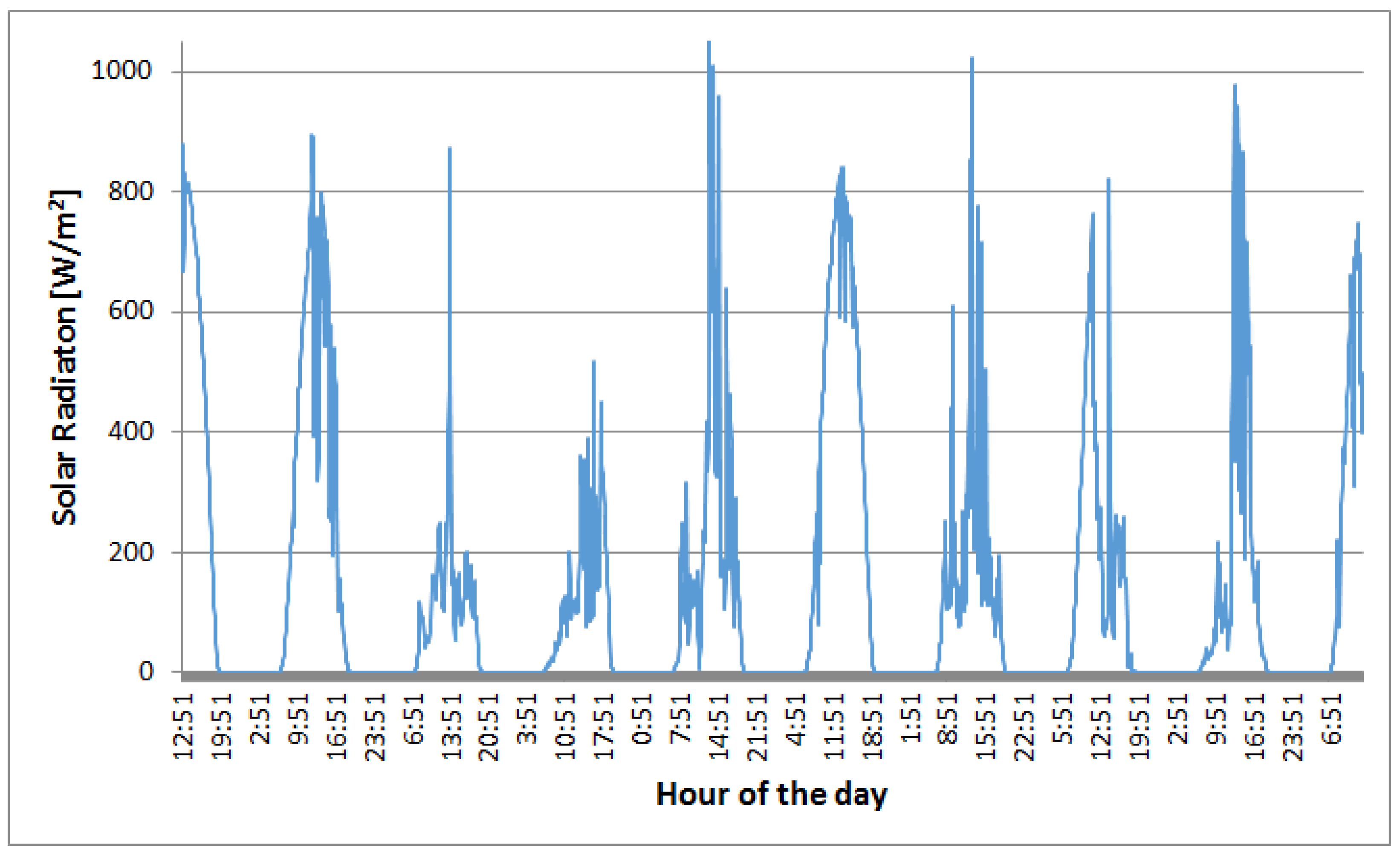
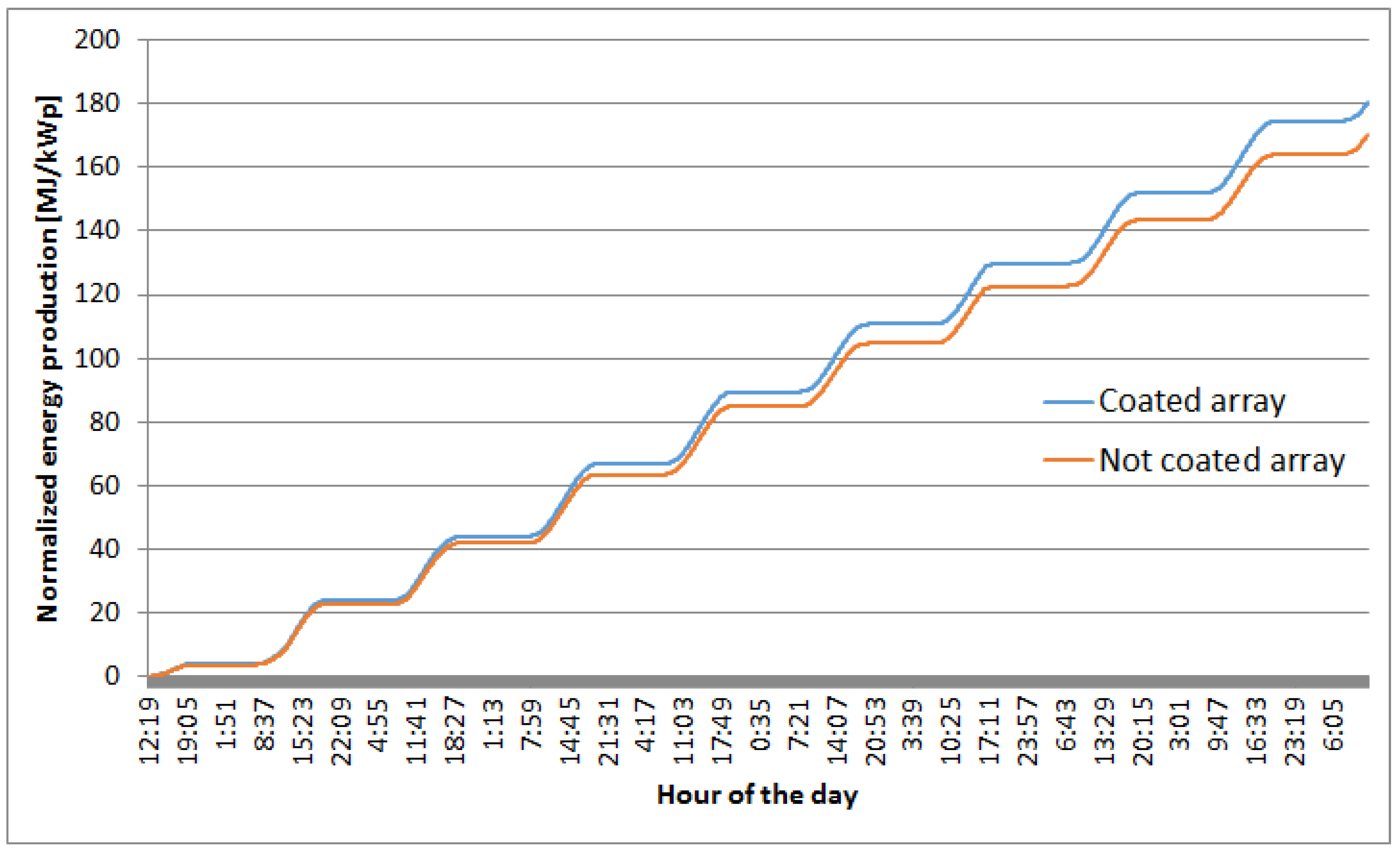
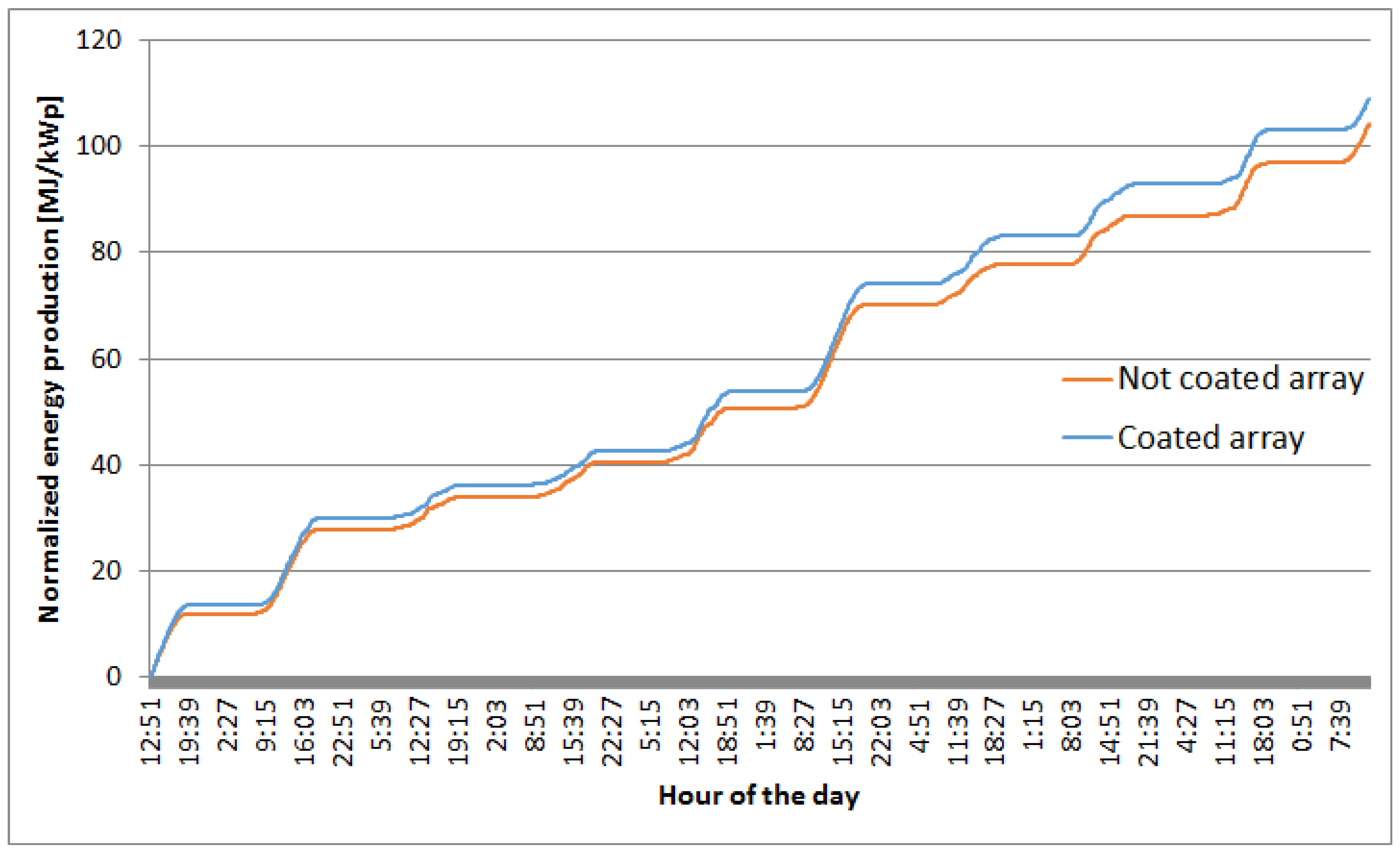
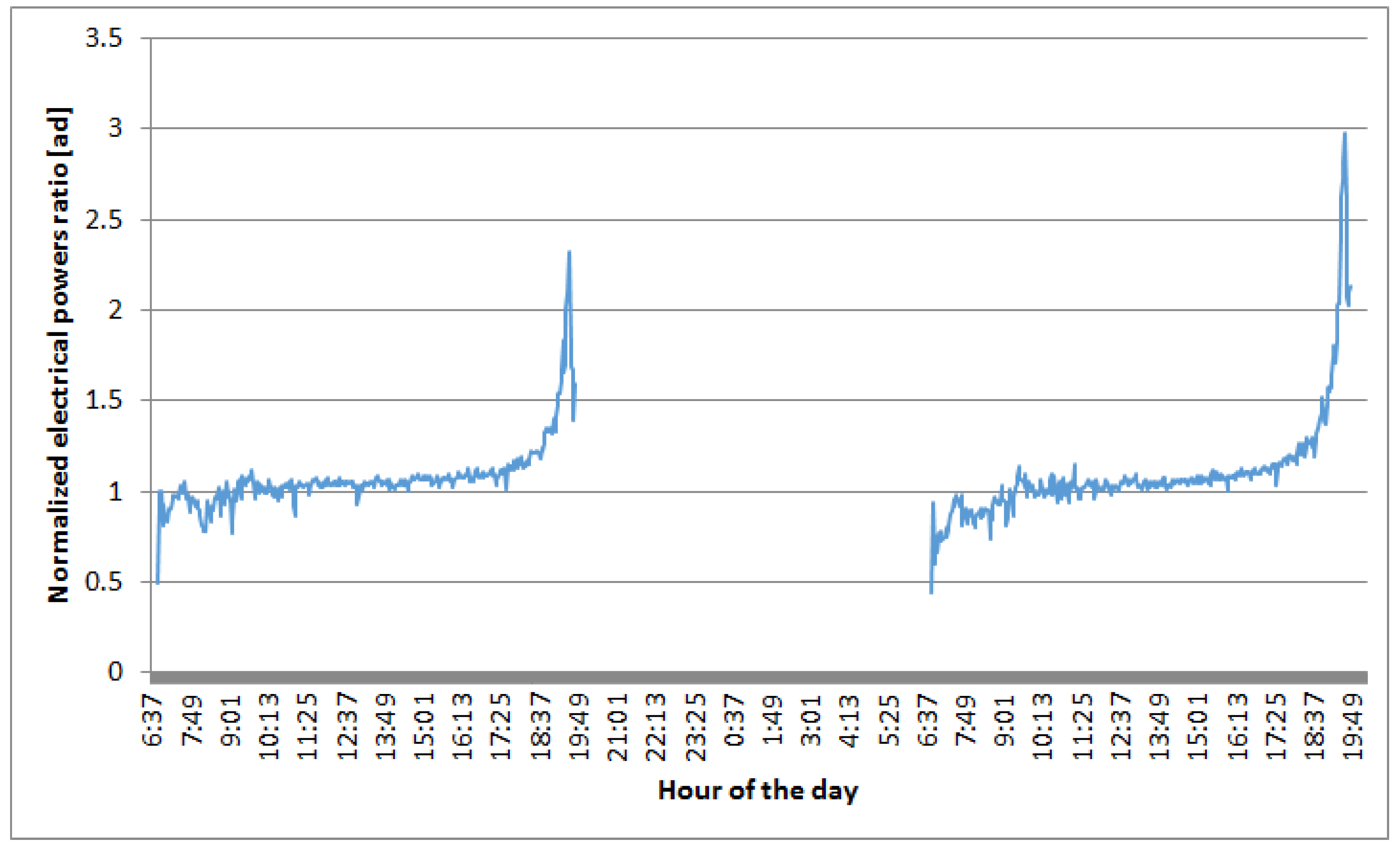
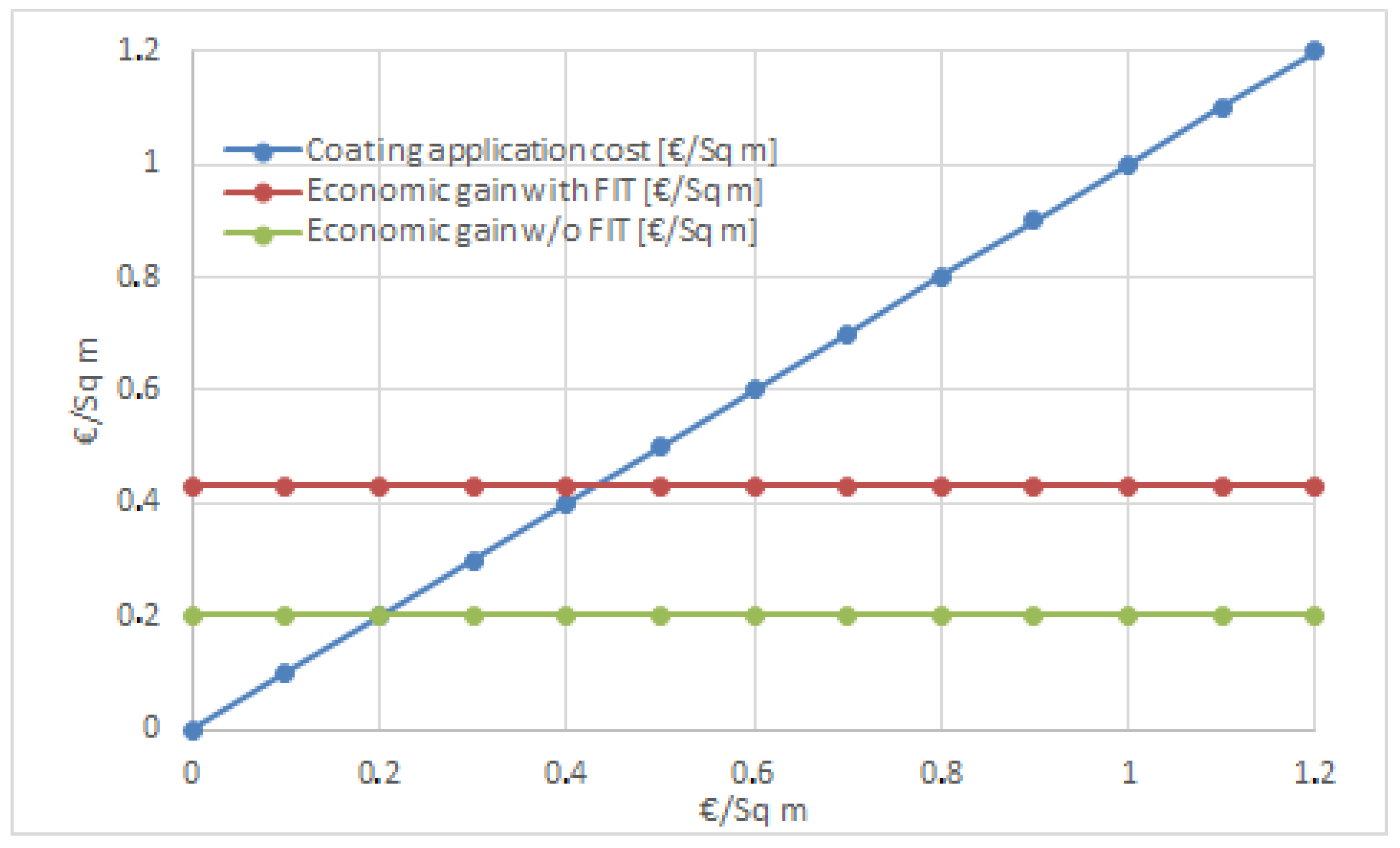
| Variable | i = 1, j = 1 | i = 2, j = 1 | i = 1, j = 2 | i = 2, j = 2 |
|---|---|---|---|---|
| Electrical energy [MJ] | 438.05 | 391.39 | 265 | 238.54 |
| Correction factor [ad] | 0.96 | 1 | ||
| Electrical energy normalized [MJ/kW] | 180.33 | 170.17 | 109.08 | 104.15 |
| Energy gain [%] | 5.97 | 4.73 | ||
| Conversion efficiency [%] | 13 | 12.77 | 13.22 | 13.13 |
| Efficiency gain | 1.82 | 0.69 | ||
| Variable | i = 1, Clouds | i = 2, Clouds | i = 1, Sun | i = 2, Sun |
|---|---|---|---|---|
| Electrical energy [MJ] | 9.84 | 8.86 | 54.99 | 49.23 |
| Correction factor [ad] | 0.96 | 1 | ||
| Electrical energy normalized [MJ/kW] | 4.05 | 3.85 | 22.64 | 21.40 |
| Energy gain [%] | 5.19 | 5.79 | ||
| Conversion efficiency [%] | 14.2 | 14.06 | 13.17 | 12.97 |
| Efficiency gain | 1 | 1.53 | ||
© 2018 by the authors. Licensee MDPI, Basel, Switzerland. This article is an open access article distributed under the terms and conditions of the Creative Commons Attribution (CC BY) license (http://creativecommons.org/licenses/by/4.0/).
Share and Cite
Pedrazzi, S.; Allesina, G.; Muscio, A. Are Nano-Composite Coatings the Key for Photovoltaic Panel Self-Maintenance: An Experimental Evaluation. Energies 2018, 11, 3448. https://doi.org/10.3390/en11123448
Pedrazzi S, Allesina G, Muscio A. Are Nano-Composite Coatings the Key for Photovoltaic Panel Self-Maintenance: An Experimental Evaluation. Energies. 2018; 11(12):3448. https://doi.org/10.3390/en11123448
Chicago/Turabian StylePedrazzi, Simone, Giulio Allesina, and Alberto Muscio. 2018. "Are Nano-Composite Coatings the Key for Photovoltaic Panel Self-Maintenance: An Experimental Evaluation" Energies 11, no. 12: 3448. https://doi.org/10.3390/en11123448
APA StylePedrazzi, S., Allesina, G., & Muscio, A. (2018). Are Nano-Composite Coatings the Key for Photovoltaic Panel Self-Maintenance: An Experimental Evaluation. Energies, 11(12), 3448. https://doi.org/10.3390/en11123448







